Ischia
Ischia (/ˈɪskiə/ ISK-ee-ə, Italian: [ˈiskja]) is a volcanic island in the Tyrrhenian Sea. It lies at the northern end of the Gulf of Naples, about 30 kilometres (19 miles) from the city of Naples. It is the largest of the Phlegrean Islands. Roughly trapezoidal in shape, it measures approximately 10 km (6 miles) east to west and 7 km (4 miles) north to south and has about 34 km (21 miles) of coastline and a surface area of 46.3 square kilometres (17.9 sq mi). It is almost entirely mountainous; the highest peak is Mount Epomeo, at 788 metres (2,585 feet).[3] The island is very densely populated, with 60,000 residents (more than 1,300 inhabitants per square km).
| Ischia | |
|---|---|
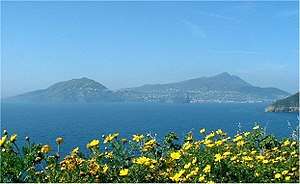 View of Ischia from Procida | |
| Highest point | |
| Elevation | 789 m (2,589 ft) |
| Coordinates | 40°43′52″N 13°53′45″E |
| Geography | |
 Ischia 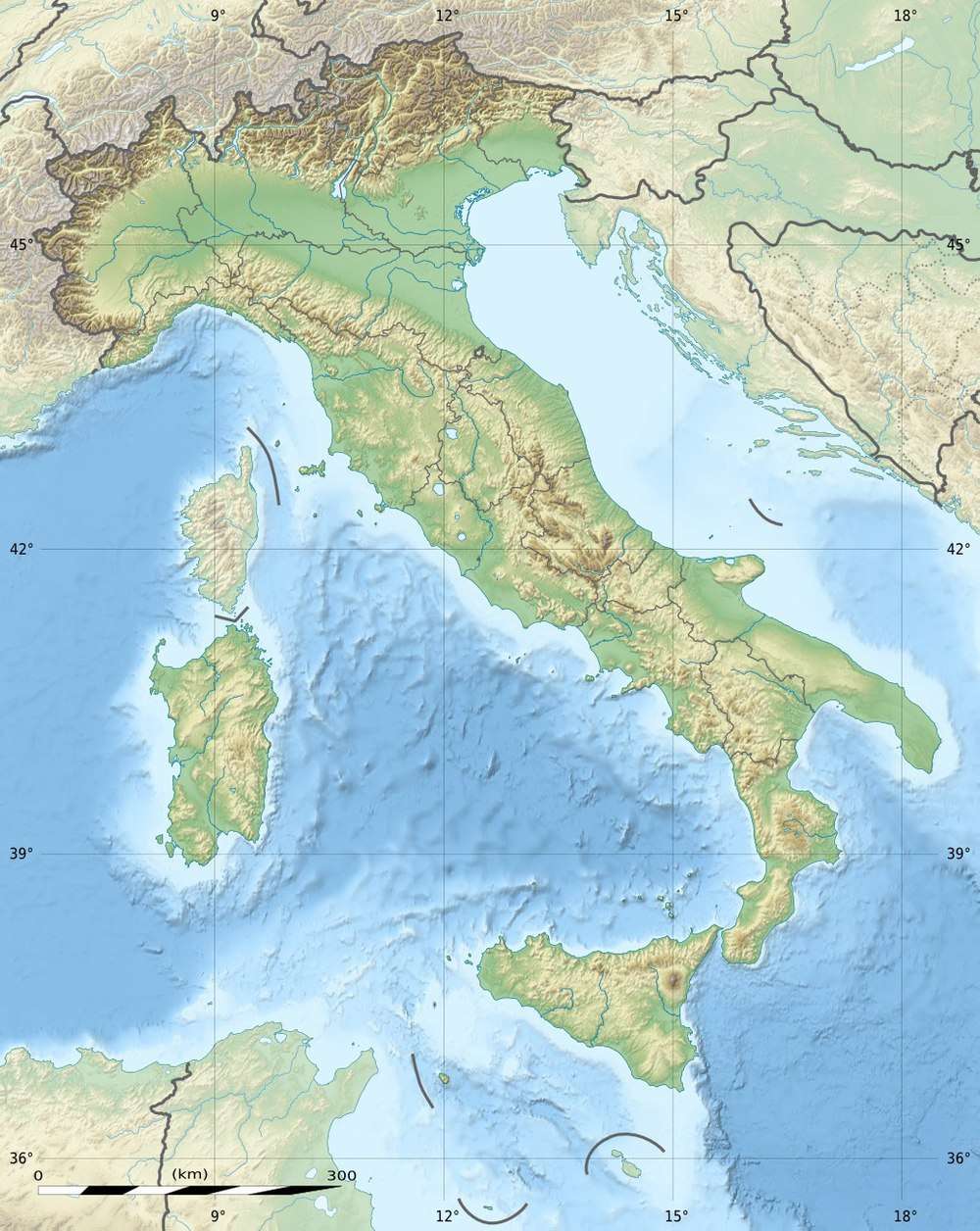 Ischia Ischia (Italy) | |
| Geology | |
| Mountain type | Complex volcano |
| Last eruption | January to March 1302[1][2] |
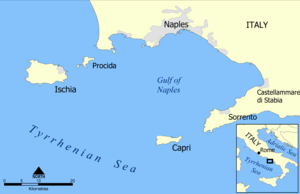 | |
| Geography | |
|---|---|
| Location | Tyrrhenian Sea |
| Area | 46.3 km2 (17.9 sq mi) |
| Highest elevation | 789 m (2,589 ft) |
| Highest point | Mount Epomeo |
| Administration | |
Italy | |
| Region | Campania |
| Metropolitan City | Naples |
| Largest settlement | Ischia (pop. 18,253) |
| Demographics | |
| Population | 62,027 (2009) |
| Pop. density | 1,339.7/km2 (3,469.8/sq mi) |
Ischia is the name of the main comune of the island. The other comuni of the island are Barano d'Ischia, Casamicciola Terme, Forio, Lacco Ameno, and Serrara Fontana.
Ischia's main industry is tourism, centering on thermal spas that cater mostly to European (especially German), American and Asian tourists eager to enjoy the fruits of the island's natural volcanic activity, its hot springs, and its volcanic mud.
Geology and geography
The roughly trapezoidal island is formed by a complex volcano immediately southwest of the Campi Flegrei area at the western side of the Bay of Naples. The eruption of the trachytic Green Tuff Ignimbrite about 56,000 years ago was followed by caldera formation. The highest point of the island, Monte Epomeo (788 m (2,585 ft)), is a volcanic horst consisting of green tuff that was submerged after its eruption and then uplifted. Volcanism on the island has been significantly affected by tectonism that formed a series of horsts and grabens; resurgent doming produced at least 800 m (2,600 ft) of uplift during the past 33,000 years.[4] Many small monogenetic volcanoes formed around the uplifted block. Volcanism during the Holocene produced a series of pumiceous tephras, tuff rings, lava domes, and lava flows.[5][6] The last eruption of Ischia, in 1302, produced a spatter cone and the Arso lava flow, which reached the NE coast.
The surrounding waters including gulfs of Gaeta,[7][8] Naples and Pozzuoli are both rich and healthy, providing a habitat for around 7 species of whales and dolphins including gigantic fin and sperm whales. Special research programmes on local cetaceans have been conducted to monitor and protect this bio-diversity.[9][10]
Name
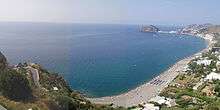
Virgil poetically referred to it as Inarime and still later as Arime.[11] Martianus Capella followed Virgil in this allusive name, which was never in common circulation: the Romans called it Aenaria, the Greeks, Πιθηκοῦσαι, Pithekoūsai.[12]
(In)arime and Pithekousai both appear to derive from words for "monkey" (Etruscan arimos,[13] Ancient Greek πίθηκος, píthēkos, "monkey"). However, Pliny derives the Greek name from the local ceramic clay deposits, not from píthēkos; he explains the Latin name Aenaria as connected to a landing by Aeneas (Princeton Encyclopedia). If the island actually was, like Gibraltar, home to a population of monkeys, they were already extinct by historical times as no record of them is mentioned in ancient sources.
The current name appears for the first time in a letter from Pope Leo III to Charlemagne in 813: the name iscla mentioned there would allegedly derive from insula, though there is an argument made for a Semitic origin in I-schra, "black island".
History
Ancient times
An acropolis site of the Monte Vico area was inhabited from the Bronze Age, as Mycenaean and Iron Age pottery findings attest. Euboean Greeks from Eretria and Chalcis arrived in the 8th century BC to establish an emporium for trade with the Etruscans of the mainland. This settlement was home to a mixed population of Greeks, Etruscans, and Phoenicians. Because of its fine harbor and the safety from raids afforded by the sea, the settlement of Pithecusae became successful through trade in iron and with mainland Italy; in 700 BC Pithecusae was home to 5,000–10,000 people.[14]
The ceramic Euboean artifact inscribed with a reference to "Nestor's Cup" was discovered in a grave on the island in 1953. Engraved upon the cup are a few lines written in the Greek alphabet. Dating from c. 730 BC, it is one of our most important testimonies to the early Greek alphabet, from which the Latin alphabet descended via the Etruscan alphabet. According to certain scholars the inscription also might be the oldest written reference to the Iliad.
In 474 BC, Hiero I of Syracuse came to the aid of the Cumaeans, who lived on the mainland opposite Ischia, against the Etruscans and defeated them on the sea. He occupied Ischia and the surrounding Parthenopean islands and left behind a garrison to build a fortress before the city of Ischia itself. This was still extant in the Middle Ages, but the original garrison fled before the eruptions of 470 BC and the island was taken over by Neapolitans. The Romans seized Ischia (and Naples) in 322 BC.
From 1st century AD to 16th century

In 6 AD, Augustus restored the island to Naples in exchange for Capri. Ischia suffered from the barbarian invasions, being taken first by the Heruli then by the Ostrogoths, being ultimately absorbed into the Eastern Roman Empire. The Byzantines gave the island over to Naples in 588 and by 661 it was being administered by a Count liege to the Duke of Naples. The area was devastated by the Saracens in 813 and 847; in 1004 it was occupied by Henry II of Germany; the Norman Roger II of Sicily took it in 1130 granting the island to the Norman Aldoyn de Candida created Count d’Ischia; the island was raided by the Pisans in 1135 and 1137 and subsequently fell under the Hohenstaufen and then Angevin rule. After the Sicilian Vespers in 1282, the island rebelled, recognizing Peter III of Aragon, but was retaken by the Angevins the following year. It was conquered in 1284 by the forces of Aragon and Charles II of Anjou was unable to successfully retake it until 1299.
As a consequence of the island's last eruption in 1302, the population fled to Baia where they remained for 4 years. In 1320 Robert of Anjou and his wife Sancia visited the island and were hosted by Cesare Sterlich, who had been sent by Charles II from the Holy See to govern the island in 1306 and was by this time nearly 100 years of age.
Ischia suffered greatly in the struggles between the Angevin and Durazzo dynasties. It was taken by Carlo Durazzo in 1382, retaken by Louis II of Anjou in 1385 and captured yet again by Ladislaus of Naples in 1386; it was sacked by the fleet of the Antipope John XXIII under the command of Gaspare Cossa in 1410 only to be retaken by Ladislaus the following year. In 1422 Joan II gave the island to her adoptive son Alfonso V of Aragon, though, when he fell into disgrace, she retook it with the help of Genoa in 1424. In 1438 Alfonso reoccupied the castle, kicking out all the men and proclaiming it an Aragonese colony, marrying to his garrison the wives and daughters of the expelled. He set about building a bridge linking the castle to the rest of the island and he carved out a large gallery, both of which are still to be seen today. In 1442, he gave the island to one of his favorites, Lucretia d'Alagno, who in turn entrusted the island's governance to her brother-in-law, Giovanni Torella. Upon the death of Alfonso in 1458, they returned the island to the Angevin side. Ferdinand I of Naples ordered Alessandro Sforza to chase Torella out of the castle and gave the island over, in 1462, to Garceraldo Requesens. In 1464, after a brief Torellan insurrection, Marino Caracciolo was set up as governor.
In February 1495, with the arrival of Charles VIII, Ferdinand II landed on the island and took possession of the castle, and, after having killed the disloyal castellan Giusto di Candida with his own hands, left the island under the control of Innico d'Avalos, marquis of Pescara and Vasto, who ably defended the place from the French flotilla. With him came his sister Costanza and through them they founded the D'Avalos dynasty which would last on the island into the 18th century.
16th–18th centuries
Throughout the 16th century, the island suffered the incursions of pirates and Barbary privateers from North Africa – in 1543 and 1544 Hayreddin Barbarossa laid waste to the island, taking 4,000 prisoners in the process. In 1548 and 1552, Ischia was beset by his successor Dragut Rais. With the increasing rarity and diminishing severity of the piratical attacks later in the century and the construction of better defenses, the islanders began to venture out of the castle and it was then that the historic centre of the town of Ischia was begun. Even so, many inhabitants still ended up slaves to the pirates, the last known being taken in 1796. During the 1647 revolution of Masaniello, there was an attempted rebellion against the feudal landowners.
Since the 18th century
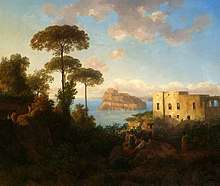
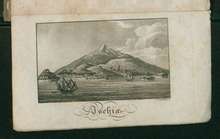
With the extinction of the D'Avalos line in 1729, the island reverted to state property. In March 1734 it was taken by the Bourbons and administered by a royal governor seated within the castle. The island participated in the short-lived Republic of Naples starting in March 1799 but by 3 April Commodore Thomas Troubridge under the command of Lord Nelson had put down the revolt on Ischia as well as on neighboring Procida. By decree of the governor, many of the rebels were hanged in a square on Procida now called Piazza dei martiri (Square of the Martyrs). Among these was Francesco Buonocore who had received the island to administer from the French Championnet in Naples. On 13 February 1806 the island was occupied by the French and on the 24th was unsuccessfully attacked by the British.
On 21st and 22 June 1809 the islands of Ischia and Procida were attacked by an Anglo-Bourbon fleet. Procida surrendered on 24 June and Ischia soon afterwards. However the British soon returned to their bases in Sicily and Malta.[15]
On 28 July 1883, an earthquake destroyed the villages of Casamicciola Terme and Lacco Ameno.
In 1936 Ischia had a population of 30,418.[16]
On August 21st, 2017 Ischia had an 4.2 magnitude earthquake[17] which killed 2 people and injured 42 more.[18][19]
Today, Ischia is a popular tourist destination, welcoming up to 6 million visitors per year, mainly from the Italian mainland as well as Germany (approximately 5,000 Germans are resident on the island), although it has become an increasingly popular destination for the well-to-do Eastern Europeans (particularly Russia and Poland). Ischia is easily reached by ferry from Naples, with an approximate travel time of between 40 minutes and one hour. The number of thermal spas on the islands makes it particularly popular with tourists seeking "wellness" holidays. A regular visitor is Angela Merkel, the German chancellor.
In literature and the arts
Events
The island is home to the Ischia Film Festival, an international cinema competition celebrated in June or July, dedicated to all the works that have promoted the value of the local territory.
Notable guests and works
- The Italian politician Giuseppe Garibaldi, one of the most important figures of Italian unification, stayed on the island for healing himself from a serious injury and finding relief in the peaceful area of Casamicciola Terme (at the Manzi Hotel).
- In May 1948 W. H. Auden wrote his poem "In Praise of Limestone" here, the first poem he wrote in Italy.[20]
- In 1949, British classical composer William Walton settled in Ischia. In 1956, he sold his London house and took up full-time residence on Ischia; he built a hilltop house at Forio, called it La Mortella, and Susana Walton created a magnificent garden there.[21] Walton lived on the island for the remainder of his life and died there in 1983.[22]
- German composer Hans Werner Henze lived on the island from 1953 to 1956 and wrote his Quattro Poemi (1955) there.
- Samuel Taylor's Broadway play Avanti! (1968) takes place on the island.
- Hergé's series of comic albums, The Adventures of Tintin (1907–1983), ends in Ischia, which serves as the location of Endaddine Akass' villa in the unfinished 24th and final book, Tintin and Alph-Art.
- French novelist Pascal Quignard set much of his novel Villa Amalia (2006) on the island.
- In Elena Ferrante's series of Neapolitan Novels, the island serves as the setting of several summer holidays of the main characters.
Motion picture setting
In addition to the works noted above, multiple media works have been set or filmed on the island. For example:
- The American film The Crimson Pirate (1952) was filmed on the island.
- Part of Cleopatra (1963), starring Elizabeth Taylor, was filmed on the island.
- Ischia Ponte stood in for 'Mongibello' in the Hollywood film of The Talented Mr. Ripley (1999).[23]
- The American film And While We Were Here (2012), starring Kate Bosworth, was filmed on the island of Ischia.[24]
- Ischia's Castello Aragonese was used as the 'Riva's Fortified Fortress' island in Men in Black: International (2019)[25]
Wines
The island of Ischia is home to the eponymous Denominazione di origine controllata (DOC) that produces both red and white wines though white wines account for nearly 80% of the island's wine production. Vineyards planted within the 179 hectares (440 acres) boundaries of the DOC tend to be on volcanic soils with high pumice, phosphorus and potassium content.[26]
The white wines of the island are composed primarily of Forastera (at least 65% according to DOC regulation) and Biancolella (up to 20%) with up to 15% of other local grape varieties such as Arilla and San Lunardo. Grapes are limited to a harvest yield of no more than 10 tonnes/ha with a finished minimum alcohol level of at least 11%. For wines labeled as Bianco Superiore, the yield is further restricted to a maximum of 8 tonnes/ha with a minimum alcohol level of 12%. Only certain subareas of the Ischia DOC can produce Bianco Superiore with the blend needing to contain 50% Forastera, 40% Biancolella and 10% San Lunardo.[26]
Red wines produced under the Ischia DOC are composed of 50% Guarnaccia, 40% Piedirosso (known under the local synonym of Per'e Palummo) and 10% Barbera. Like the white wines, red grapes destined for DOC production are limited to a harvest yield of no more than 10 tonnes/ha though the minimum finished alcohol level is higher at 11.5% ABV.[26]
Main sights
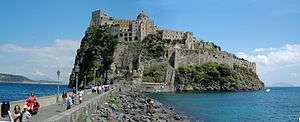
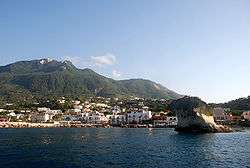
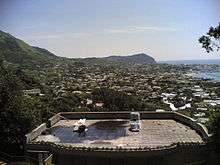
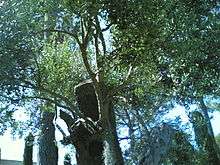
Aragonese Castle
The Aragonese Castle (Castello Aragonese, Ischia Ponte) was built on a rock near the island in 474 BC, by Hiero I of Syracuse. At the same time, two towers were built to control enemy fleets' movements. The rock was then occupied by Parthenopeans (the ancient inhabitants of Naples). In 326 BC the fortress was captured by Romans, and then again by the Parthenopeans. In 1441 Alfonso V of Aragon connected the rock to the island with a stone bridge instead of the prior wood bridge, and fortified the walls in order to defend the inhabitants against the raids of pirates. Around 1700, about 2000 families lived on the islet, including a Poor Clares convent, an abbey of Basilian monks (of the Greek Orthodox Church), the bishop and the seminar, and the prince, with a military garrison. There were also thirteen churches. In 1912, the castle was sold to a private owner. Today the castle is the most visited monument of the island. It is accessed through a tunnel with large openings which let the light enter. Along the tunnel there is a small chapel consecrated to Saint John Joseph of the Cross (San Giovan Giuseppe della Croce), the patron saint of the island. A more comfortable access is also possible with a modern lift. After arriving outside, it is possible to visit the Church of the Immacolata and the Cathedral of Assunta. The first was built in 1737 on the location of a smaller chapel dedicated to Saint Francis, and closed after the suppression of convents in 1806, as well as the Poor Clares convent.
Gardens of La Mortella
The gardens, located in Forio-San Francesco, were originally the property of English composer William Walton. Walton lived in the villa next to the gardens with his Argentinian wife Susana. When the composer arrived on the island in 1946, he immediately called Russell Page from England to lay out the garden. Wonderful tropical and Mediterranean plants were planted and some have now reached amazing proportions. The gardens include wonderful views over the city and harbour of Forio. A museum dedicated to the life and work of William Walton now comprises part of the garden complex. There's also a recital room where renowned musical artists perform on a regular schedule.
Gardens of Villa Ravino
A botanical garden, located in Forio-Citara Bay, is the result of 50 years of the dedicated work of Captain Giuseppe D'Ambra, the owner of the Villa. Giardini Ravino is a botanical garden with one of the richest collection of cacti and succulents cultivated outdoors in Europe. Giardini Ravino has been the subject of an award from the OPE (European Parliamentary Observatory) for the most ecofriendly property in South Italy.
Giardini Ravino is also the location of Meristema Fair, an exhibition dedicated to both professional and quality amateur gardeners, enriched with seminars and hands on experiences regarding biodiversity in nature. Giardini Ravino is also the headquarters of many social associations that organize events, in collaboration with international humanitarian aid organizations, such as MSF (Doctors Without Borders), the non-profit eco-gastronomic member-supported organization Slow Food and many other cultural exhibitions during the year around.
Villa La Colombaia
Villa La Colombaia is located in Lacco Ameno and Forio territories. Surrounded by a park, the villa (called "The Dovecote") was made by Luigi Patalano, a famous local socialist and journalist. It is now the seat of a cultural institution and museum dedicated to Luchino Visconti. The institution promotes cultural activities such as music, cinema, theatre, art exhibitions, workshops, and cinema reviews. The villa and the park are open to the public.
Others
- Sant'Angelo (Sant'Angelo, in the comune of Serrara Fontana)
- Maronti Beach (Barano d'Ischia)
- Church of the Soccorso' (Forio)
- Piazza S.Restituta, with the best luxury boutiques (Lacco Ameno)
- Bay of Sorgeto, with hot thermal springs (Panza)
- Poseidon Gardens – spa with several thermal pools (Panza)
- Citara Beach (Panza)
- English's Beach (Ischia)
- Pitthekoussai Archaeological museum[27]
- The Angelo Rizzoli museum[27]
Voluntary associations
Committees and associations work to promote tourism on the island, and provide services and activities for residents. Among these are:
- Il coniglio di Rocco Alfarano, associazione per la protezione del quadrupede sull’isola
- Accaparlante Società Cooperativa Sociale, Via Sant'Alessandro
- Associazione Donatori Volontari di Sangue, Via Iasolino, 1
- Associazione Nemo per la Diffusione della Cultura del Mare, via Regina Elena, 75 Cellulare: 366-1270197
- Associazione Progetto Emmaus, Via Acquedotto, 65
- A.V.I. Associazione Volontariato e Protezione Civile Isola D'Ischia, Via Delle Terme, 88
- Cooperativa Sociale Arkè onlus, Via delle Terme, 76/R Telefono: 081-981342
- Cooperativa Sociale Asat Ischia onlus, Via delle Terme, 76/R Telefono: 081-3334228
- Cooperativa Sociale kairòs onlus, Via delle Terme, 76/R
- Kalimera Società Cooperativa Sociale, Via Fondo Bosso, 20
- Pan Assoverdi Salvanatura, Via Delle Terme, 53/C
- Prima Ischia – Onlus, Via Iasolino, 102
Town twinning



Many migrants from Ischia also settled in the port town San Pedro, California, the college town of Princeton, New Jersey, the Bath Beach section of Brooklyn, NY, Providence, RI, Philadelphia, and Norwalk, Connecticut.from 1918 through 1929 many settled in the Hells Kitchen section of N.Y., N.Y and found employment on the waterfront.
Environmental problems
The sharp increase of the population between 1950 and 1980 and the growing inflow of tourists (in 2010 over 4 million tourists visited the island for at least one day) have increased the anthropic pressure on the island. Significant acreage of land previously used for agriculture has been developed for the construction of houses and residential structures. Most of this development has taken place without any planning and building permission.[31] As at the end of 2011, the island lacked the most basic system for sewage treatment; sewage is sent directly to the sea. In 2004 one of the five communities of the island commenced civil works to build a sewage treatment plant but since then the construction has not been completed and it is currently stopped.
On 14 June 2007 there was a breakage in one of the four high-voltage underwater cables forming the power line maintained by Enel S.p.A — although never authorized by Italian authorities — between Cuma on the Campania coast and Lacco Ameno on the island of Ischia. Inside each cable there is an 18 mm‑diameter channel filled with oil under high pressure.[32] The breakage of the Enel cable resulted in the spillage of oil into the sea and into other environmental matrices — with the consequent pollution by polychlorobiphenyls (PCBs, the use of which was banned by the Italian authorities as long ago as 1984), polycyclic aromatic hydrocarbons (PAHs) and linear alkyl benzenes (aromatic hydrocarbons) — in the ‘Regno di Nettuno’, a marine protected area, and the largest ecosystem in the Mediterranean Sea, designated as a ‘priority habitat’ in Annex I to the Habitats Directive (92/43/EEC) and comprising oceanic posidonia beds.
See also
References
- "Ischia: Eruptive History". Global Volcanism Program. Smithsonian Institution.
- Ischia: Eruptive History volcano.si.edu, accessed 28 September 2019
- "Mount Epomeo". Princeton Encyclopedia of Classical Sites.
- "Ischia". Global Volcanism Program. Smithsonian Institution. Retrieved 28 September 2019.
- "Ischia: Synonyms and Subfeatures". Global Volcanism Program. Smithsonian Institution.
- Ischia: Synonyms and Subfeatures volcano.si.edu, accessed 28 September 2019
- 2016. Orca avvistata (Orca sighted) www.caiccomed.com, accessed 21 September 2019
- D'Alelio D.. 2016. Laggiu soffia! Cronaca di una “caccia” al capodoglio nelle acque tra Ischia e Ventotene – Leviatani, nascosti e preziosi. The Scienza Live. Retrieved on March 29, 2017
- Mussi B.. Miragliuolo A.. Monzini E.. Battaglia M.. 1999. Fin whale (Balaenoptera physalus) feeding ground in the coastal waters of Ischia (Archipelago Campano) (pdf). The European Cetacean Society. Retrieved on March 28, 2017
- RAICALDO P.. 2014. Delfini e capodogli tra Ischia e Procida. Retrieved on March 29, 2017
- His poetical allusion was apparently to the mention in Iliad (ii.783) of Typhoeus being chained down ein Arimois
- The plural likely so as to include nearby Procida as well.
- Robinson, Andrew (2002). Lost Languages: The Enigma of the World's Undechiphered Scripts. Nevraumont Publishing.
- Jonathan M. Hall (2013). A History of the Archaic Greek World, ca. 1200–479 BCE. John Wiley & Sons. p. 124. ISBN 978-1-118-34046-2.
- "ISCHIA - A brief history of Ischia - Austrians and Bourbons - HOTEL ISCHIA - OFFERTE HOTEL ISCHIA". www.ischiaonline.it. Retrieved 8 March 2018.
- Columbia-Lippincott Gazetteer, p. 849
- Terremoto di magnitudo Mw 3.9 del 21-08-2017 ore 20:57:51 (Italia) in zona: 1 km SW Casamicciola Terme (NA) cnt.rm.ingv.it, accessed 21 September 2019
- Terremoto a Ischia, due morti e 52 feriti. Salvati i fratelli rimasti sepolti Borrelli: ‘Case con materiali scadenti’ www.corriere.it, accessed 21 September 2019
- Forte terremoto a Ischia, crolli a Casamicciola. Due morti e almeno 39 feriti. Salvi tutti e tre i fratelli rimasti imprigionati sotto le macerie www.lastampa.it, accessed 21 September 2019
- "Auden, Wystan Hugh (1907–1973), poet and writer - Oxford Dictionary of National Biography". www.oxforddnb.com. doi:10.1093/ref:odnb/9780198614128.001.0001/odnb-9780198614128-e-30775. Retrieved 16 June 2019.
- Kennedy, pp. 208–209
- Kennedy, pp. 75, 140, 143, 144 and 208
- The Talented Mr Ripley (1999) film locations Movie-Locations.com, Retrieved November 1, 2019
- Fred Topel- Exclusive Interview: Kat Coiro on And While We Were Here 17 September 2013, www.mandatory.com, accessed 21 September 2019
- Men In Black International (2019) film locations Movie-Locations.com] Retrieved November 1, 2019
- Saunders, P. (2004). Wine Label Language. Firefly Books. pp. 169–170. ISBN 1-55297-720-X.
- "Museo Angelo Rizzoli – Museums – Ischia – Napoli". InCampania. Archived from the original on 2013-09-21. Retrieved 2013-03-26.
- "Sister Cities of Los Angeles". Retrieved 2017-01-09.
- "A Message from the Peace Commission: Information on Cambridge's Sister Cities," 15 February 2008. Retrieved 2008-10-12.
- Richard Thompson. "Looking to strengthen family ties with 'sister cities'," Boston Globe, October 12, 2008. Retrieved 2008-10-12.
- Pleijel, Christian (2015-10-22). "ENERGY AUDIT ON ISCHIA" (PDF).
- "Written question - Environmental catastrophe in Ischia - E-3253/2008". www.europarl.europa.eu. Retrieved 8 March 2018.
Bibliography
- Richard Stillwell, ed. Princeton Encyclopedia of Classical Sites, 1976: "Aenaria (Ischia), Italy".
- Ridgway, D. "The First Western Greeks" Cambridge University Press, 1993. ISBN 0-521-42164-0
- Kennedy, Michael (1989). Portrait of Walton. Oxford: Oxford University Press. ISBN 978-0-19-816705-1.
External links
| Wikimedia Commons has media related to Ischia (island). |
| Wikivoyage has a travel guide for Ischia. |
- Ischia at Curlie
- Ischia Photos with maps [en]
- Archaeology of Ischia (in Italian)